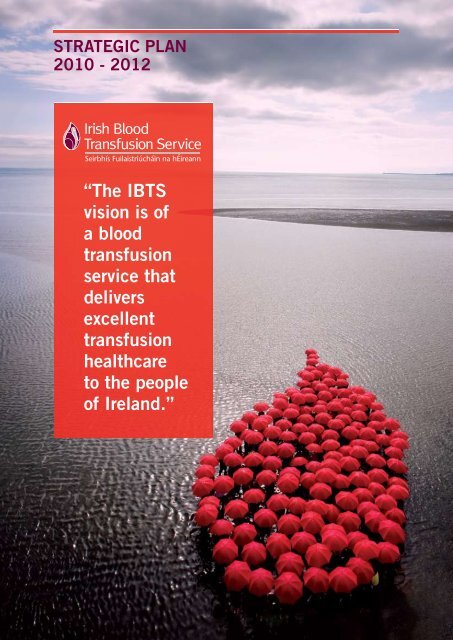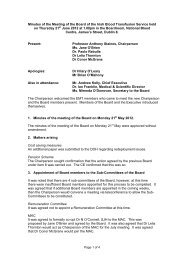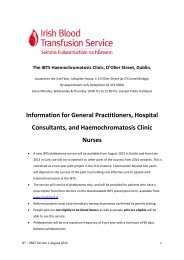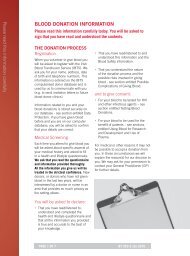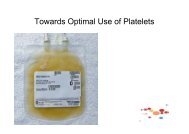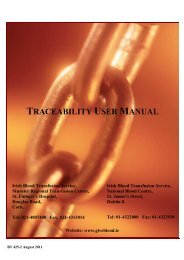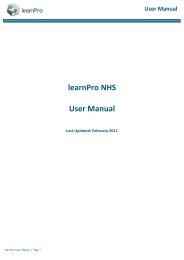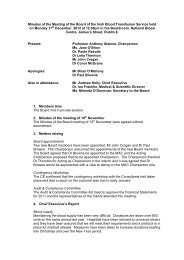IBTS Strategic Plan 2010 - 2012.pdf - Irish Blood Transfusion Service
IBTS Strategic Plan 2010 - 2012.pdf - Irish Blood Transfusion Service
IBTS Strategic Plan 2010 - 2012.pdf - Irish Blood Transfusion Service
Create successful ePaper yourself
Turn your PDF publications into a flip-book with our unique Google optimized e-Paper software.
<strong>Strategic</strong> <strong>Plan</strong> <strong>2010</strong> - 2012 1<br />
STRATEGIC PLAN<br />
<strong>2010</strong> - 2012<br />
“The <strong>IBTS</strong><br />
vision is of<br />
a blood<br />
transfusion<br />
service that<br />
delivers<br />
excellent<br />
transfusion<br />
healthcare<br />
to the people<br />
of Ireland.”
2<br />
<strong>Irish</strong> <strong>Blood</strong> <strong>Transfusion</strong> <strong>Service</strong>
<strong>Strategic</strong> <strong>Plan</strong> <strong>2010</strong> - 2012 3<br />
Contents<br />
<strong>Strategic</strong> <strong>Plan</strong> <strong>2010</strong> - 2012 6<br />
Governance Structure 9<br />
Who we are 10<br />
Context for the <strong>Strategic</strong> <strong>Plan</strong> <strong>2010</strong> – 2012 13<br />
<strong>Strategic</strong> Direction 15<br />
:01 To provide a sustainable and safe blood supply and services that will meet all safety<br />
and compliance standards 16<br />
:02 Maintain International Best Practice 19<br />
:03 The provision of appropriate patient services that meet the needs of patients and clinicians 20<br />
:04 Adapting to the Changing Business Environment 22<br />
:05 Relationships and Alliances 26<br />
:06 Reconfiguration of <strong>Service</strong>s 27<br />
Finance Strategy 29
4<br />
<strong>Irish</strong> <strong>Blood</strong> <strong>Transfusion</strong> <strong>Service</strong><br />
“The drive to deliver<br />
value for money,<br />
in the context of<br />
an overall more<br />
efficient service will<br />
not diminish our<br />
commitment to a safe<br />
and quality focused<br />
service to patients<br />
and donors.”
<strong>Strategic</strong> <strong>Plan</strong> <strong>2010</strong> - 2012 5<br />
Foreword<br />
I am pleased to present the <strong>IBTS</strong> <strong>Strategic</strong> <strong>Plan</strong><br />
for <strong>2010</strong> – 2012. The challenges facing the public<br />
service at a time of great economic difficulty are<br />
many. The particular challenges facing the <strong>IBTS</strong> to<br />
continue delivering a safe, consistent blood supply<br />
to those who need it, while implementing change<br />
and achieving greater efficiencies will require the<br />
implementation of the strategic themes set out in this<br />
<strong>Plan</strong>.<br />
The <strong>Plan</strong> sets out six strategic themes and outlines<br />
the goals and objectives to be met to implement<br />
these themes over the next 3 years. It will guide the<br />
organisation’s activities over that period. The <strong>IBTS</strong><br />
will focus its energies on continuously monitoring<br />
international developments in blood transfusion and<br />
emerging threats to the blood supply, strengthening<br />
effective relationships with the Department of Health<br />
and Children, the HSE and academic institutions<br />
with an interest in blood transfusion, getting the best<br />
value from our existing resources and maximising the<br />
use of technology. This is vital in the provision of an<br />
appropriate and efficient transfusion service.<br />
The drive to deliver value for money, in the context of<br />
an overall more efficient service will not diminish our<br />
commitment to a safe and quality focused service to<br />
patients and donors.<br />
I wish to thank the Board and the staff of the <strong>IBTS</strong><br />
for their input in developing this <strong>Plan</strong>, recognising<br />
that the real tasks lie ahead, in delivering on the<br />
objectives set out in this <strong>Strategic</strong> <strong>Plan</strong>.<br />
Ms Katharine Bulbulia<br />
Chairperson
6<br />
<strong>Irish</strong> <strong>Blood</strong> <strong>Transfusion</strong> <strong>Service</strong><br />
<strong>Strategic</strong> <strong>Plan</strong><br />
<strong>2010</strong> - 2012<br />
The <strong>IBTS</strong> is a national<br />
organisation responsible for<br />
providing blood transfusion<br />
services to patients in Ireland.<br />
It relies completely on the<br />
generosity of voluntary nonremunerated<br />
donors to provide<br />
sufficient donations to ensure a<br />
consistent supply of blood and<br />
blood components to patients. It<br />
is a critical part of modern health<br />
care and provides blood, blood<br />
components and blood products<br />
for patients. It is funded through<br />
the charging of hospitals for its<br />
products and services at a price<br />
agreed with the Department of<br />
Health and Children.<br />
As a Non – Commercial State Agency its governance<br />
arrangements are set out in the revised Code of<br />
Practice for the Governance of State Agencies. The<br />
responsibility for governance of the <strong>IBTS</strong> falls on the<br />
Board which is appointed by the Minister for Health<br />
and Children and comprises twelve members. To<br />
assist the Board in carrying out its function there are<br />
a number of Sub-Committees who deal with specific<br />
aspects of the business of the organisation, namely,<br />
Medical Advisory Committee, Finance Committee,<br />
Audit and Compliance Committee, Remuneration<br />
Committee and Research Development Committee.<br />
There is a clear delineation of roles and<br />
responsibilities between the Board and the Executive.<br />
In Statutory Instrument 78 of 1965, the<br />
functions of the <strong>IBTS</strong> are described as follows:<br />
(a)<br />
(b)<br />
(c)<br />
(d)<br />
(e)<br />
to take over the property (including choses-inaction),<br />
assets, rights and liabilities of the<br />
Company;<br />
to organise and administer a blood transfusion<br />
service (hereinafter referred to as “the<br />
<strong>Service</strong>”) including the processing or supply<br />
of blood derivatives or other blood products<br />
and also including blood group and other tests<br />
in relation to specimens of blood received by<br />
the Board;<br />
to make available, blood and blood products;<br />
to make available equipment or re-agents<br />
suitable for use in relation to the service;<br />
to make such charges (if any) as the Board<br />
thinks fit, for the services referred to at (b),<br />
(c) and (d) above and, where the Minister gives<br />
any direction in relation to such charges, to<br />
comply with such direction.
<strong>Strategic</strong> <strong>Plan</strong> <strong>2010</strong> - 2012 7<br />
(f)<br />
(g)<br />
(h)<br />
(i)<br />
to furnish advice, information and assistance in<br />
relation to any aspect of the service to the<br />
Minister, any health authority or any hospital<br />
authority;<br />
to make any necessary provision for publicity in<br />
relation to the service;<br />
to organise, provide, assist or encourage<br />
research and the training and teaching<br />
of persons in matters relating to blood<br />
transfusion and the preparation of blood<br />
products and<br />
to co-operate with other bodies with analogous<br />
scientific functions.<br />
These functions were amended in 1988,<br />
2000 and 2003 as follows:<br />
•<br />
to organise and administer an eye banking<br />
service.<br />
•<br />
to organise and administer a service for<br />
obtaining and assessing reports of unexpected<br />
or undesirable effects of transfusion of blood<br />
or blood components made available by the<br />
Board, including the furnishing to the <strong>Irish</strong><br />
Medicines Board of reports of any unexpected<br />
or undesirable effects of any transfusion of<br />
such blood or blood components.<br />
• to make available clotting factor concentrates<br />
which do not contain blood or blood products,<br />
and other biological medicinal agents including<br />
recombinant protein preparations, used for<br />
the treatment of coagulation disorders and<br />
other congenital or acquired disorders that<br />
are characterized by diminished levels of, or<br />
dysfunctional forms of, plasma proteins.
8<br />
<strong>Irish</strong> <strong>Blood</strong> <strong>Transfusion</strong> <strong>Service</strong><br />
Board<br />
Medical Advisory<br />
Committee (MAC)<br />
Chief<br />
Executive<br />
Finance Committee<br />
Executive Management<br />
Team<br />
Chief Executive<br />
Operations – supply chain<br />
Quality & Compliance<br />
Medical & Scientific<br />
Human Resources<br />
Finance<br />
Audit & Compliance<br />
Committee<br />
Remuneration Committee<br />
Research Development<br />
Committee
<strong>Strategic</strong> <strong>Plan</strong> <strong>2010</strong> - 2012 9<br />
Governance<br />
Structure<br />
Organisation Structure<br />
The organisation of work is carried out through a<br />
number of key functions organised on a national<br />
basis. The primary decision making body is the<br />
Executive Management Team with a devolved<br />
budgetary system. The chart showing the current<br />
Executive Management Team is attached. The<br />
headquarters is located in Dublin with the main<br />
testing and processing centre, there is also a testing<br />
and processing centre in Cork and collections teams<br />
in Dublin, Cork, Carlow, Limerick, Ardee and Tuam<br />
with fixed donation clinics in Dublin (2) and Cork.<br />
Business Environment<br />
The <strong>IBTS</strong> operates within a highly regulated<br />
environment. The conditions applying are similar to<br />
those that operate in the pharmaceutical industry.<br />
A safe transfusion service is assured by close<br />
collaboration between the <strong>IBTS</strong> and clinicians in<br />
managing the aspects of the transfusion process<br />
for which they are responsible. Only blood, which<br />
has been donated by appropriately selected donors<br />
and has been tested for transfusion transmissible<br />
infectious agents, can be issued for transfusion.<br />
The inherent and inevitable problem is that blood<br />
transfusion is highly prone to attack from viruses<br />
and other infectious forms by its very nature.<br />
Potentially the greatest threat to the provision of<br />
a safe blood supply is the emergence of a new<br />
virus or an infectious disease where the scientific<br />
/ epidemiological origins are not very clear and for<br />
which no test has been developed. By definition<br />
once it is known that a virus/infectious disease is<br />
transmissible it has already caused harm or even<br />
fatalities. This threat will never go away, and a formal<br />
scientific approach is needed to deal with that<br />
reality rather than simply reacting to each threat as<br />
it becomes known. There are certain measures that<br />
can be implemented to limit the exposure should<br />
transmissibility be proven. The <strong>IBTS</strong> adopted this<br />
policy in the manner it has dealt particularly with<br />
the threat from vCJD and bacterial contamination<br />
in platelets. This will continue to be our approach<br />
despite the challenging economic environment.
10<br />
<strong>Irish</strong> <strong>Blood</strong> <strong>Transfusion</strong> <strong>Service</strong><br />
Who we are<br />
Our Purpose<br />
The core purpose of the <strong>IBTS</strong> is to meet the<br />
transfusion needs of patients in Ireland.<br />
Our Mission<br />
The <strong>IBTS</strong> is committed to excellence in meeting<br />
patient’s needs through the professionalism of<br />
our staff and the generosity of our donors.<br />
Our Vision<br />
The <strong>IBTS</strong> vision is of a blood transfusion service<br />
that delivers excellent transfusion healthcare to<br />
the people of Ireland.<br />
We want<br />
Patients<br />
to know that the blood they will receive<br />
will be as safe as possible.<br />
Donors<br />
to feel appreciated, respected, and<br />
satisfied with their experience.<br />
The healthcare community<br />
to recognise that the product and<br />
services that we provide meet the best<br />
international standards, essential for<br />
them to deliver their goals, and good<br />
value for the resources deployed.
<strong>Strategic</strong> <strong>Plan</strong> <strong>2010</strong> - 2012 11<br />
Achieving our vision means…<br />
Our Values<br />
Better outcome for patients<br />
Patients will know that the <strong>IBTS</strong> puts the<br />
highest priority on safety and efficacy of<br />
the products provided for transfusion.<br />
Improved recruitment and retention of<br />
donors<br />
Donors will have a satisfying and<br />
rewarding experience when donating<br />
which will improve donor loyalty.<br />
•<br />
•<br />
•<br />
•<br />
•<br />
Excellence in <strong>Service</strong><br />
Honesty<br />
Respect<br />
Learning<br />
Accountability<br />
• Teamwork<br />
Improved clinical services to healthcare<br />
staff<br />
Healthcare staff will experience clinical<br />
services that enables them to provide the<br />
best possible transfusion service to their<br />
patients.
12<br />
<strong>Irish</strong> <strong>Blood</strong> <strong>Transfusion</strong> <strong>Service</strong><br />
“The <strong>IBTS</strong> has<br />
undergone<br />
significant change<br />
over the past decade<br />
in all aspects of<br />
its business. There<br />
has been increased<br />
sophistication in<br />
the technologies<br />
used, changes to<br />
specification to<br />
products brought<br />
about by responding<br />
to emerging<br />
infections and a<br />
change in the how<br />
we carry out our<br />
business.”
<strong>Strategic</strong> <strong>Plan</strong> <strong>2010</strong> - 2012 13<br />
Context for the <strong>Strategic</strong><br />
<strong>Plan</strong> <strong>2010</strong> – 2012<br />
The environment in which the <strong>IBTS</strong> operates is ever<br />
changing and for the <strong>IBTS</strong> to operate to international<br />
best practice with constrained resources will require a<br />
new way of doing business and a more effective and<br />
efficient organisation that is flexible, agile and has the<br />
capacity to respond to the many challenges we will face<br />
in the period <strong>2010</strong> – 2012. This must be achieved within<br />
a framework of delivering better value for money in a<br />
dramatically changed economic environment.<br />
We must build on the progress made from the<br />
implementation of the <strong>Strategic</strong> <strong>Plan</strong> 2005 – 2009<br />
and respond to the changing demands of hospitals,<br />
regulators, donors and members of the public who<br />
expect the highest standard of products and service<br />
delivery.<br />
The <strong>IBTS</strong> has come to the end of the term of its first<br />
strategic plan and to develop a new <strong>Strategic</strong> <strong>Plan</strong> it<br />
is essential that the Environment in which the <strong>IBTS</strong><br />
operates is analysed to inform the new <strong>Strategic</strong> <strong>Plan</strong>.<br />
This has been carried out using the PESTEL model and<br />
the salient points are outlined below. The Performance<br />
Framework for <strong>2010</strong> has been agreed with the<br />
Department of Health and Children with specific targets<br />
across the business.<br />
Legal Framework<br />
The provision of a blood transfusion service is governed<br />
by a number of EU Directives which set out the legal<br />
framework within which the <strong>IBTS</strong> must operate. These<br />
cover the core functions of collection, processing and<br />
testing, the quality system and technology.<br />
Code of Practice for the Governance of<br />
State Bodies<br />
The Code of Practice for the Governance of State Bodies<br />
was revised in June 2009. It requires that a performance<br />
framework be developed between State agencies<br />
and their parent department, which would define the<br />
expectations that Government and Ministers have of<br />
the State Body (and the body’s own expectations),<br />
clarify the body’s role in the policy sector and define the<br />
parameters surrounding the body’s resources/income. A<br />
performance framework allows for the adoption of both<br />
annual and multiannual targets, and the development of<br />
output and outcome indicators, based on clear outputs<br />
including milestones to measure their delivery. It further<br />
requires that annual output statements should also be<br />
produced by the State agency.<br />
PESTEL Analysis<br />
Political factors<br />
The <strong>IBTS</strong> remains accountable to the Department<br />
of Health and Children, while the HSE is our main<br />
customer. Managing and growing relationships with<br />
the Department and the HSE remains a priority for the<br />
<strong>IBTS</strong>. Introducing operational and service efficiencies<br />
over the duration of this strategic plan will be achieved<br />
against a background of a constrained national industrial<br />
relations environment and a recruitment and promotion<br />
moratorium.<br />
Economic factors<br />
A cut of €1 billion on HSE expenditure has been<br />
imposed for <strong>2010</strong>, and this will have a direct impact on<br />
the level of activity in hospitals. The draft HSE <strong>Service</strong><br />
plan for <strong>2010</strong> is proposing 54,000 less admissions,<br />
which should have a direct impact on blood usage in<br />
hospitals.<br />
The implementation of the EU <strong>Blood</strong> Directive in 2006<br />
has meant that an EU-wide standard for the collection<br />
and testing of blood now applies across Europe, which<br />
opens up the possibility of competition from external<br />
suppliers.
14<br />
<strong>Irish</strong> <strong>Blood</strong> <strong>Transfusion</strong> <strong>Service</strong><br />
Context for the <strong>Strategic</strong> <strong>Plan</strong><br />
<strong>2010</strong> – 2012<br />
Significant State investment in the <strong>IBTS</strong> over the last<br />
10 years has resulted in a world class facility for the<br />
processing and testing of blood in Ireland – maintaining<br />
this standard in facilities and technologies in a recession<br />
will be a major challenge. The development of a new<br />
facility in Cork will further enhance the services available<br />
to hospitals. The resultant consolidation of services will<br />
provide for cost savings that will have to be channelled<br />
into reductions in price.<br />
The drive to achieve efficiencies and effect savings has<br />
gathered momentum and will absorb much of the effort<br />
over the next few years, as the use of scarce resources to<br />
deliver health care comes under increased scrutiny.<br />
Sociological factors<br />
The 2006 census shows that the population of Ireland<br />
had increased by 322,645, that is 8.2% over a 4 year<br />
period. The population estimate in April 2006 was 4.6<br />
million people. The number of persons aged 65 and over<br />
has increased at every census since 1961 from 315,000<br />
in that year to 468,000 in 2006. This category now<br />
represents 11% of the population. The change in this age<br />
cohort is not expected to result in an increase in demand<br />
for blood over the lifetime of this <strong>Plan</strong>.<br />
The amount of foreign travel undertaken by <strong>Irish</strong> people<br />
peaked in 2007/2008, and during those years there was<br />
an increase in the number of people travelling to exotic<br />
locations. Foreign trips taken by <strong>Irish</strong> residents declined<br />
by 6.5% to 1,927,000 in quarter 2 2009, compared to<br />
quarter 2 2008. Holiday trips fell by 15% while those<br />
for business purposes were down 5.3%. This will be<br />
reflected in a reduction in the deferrals in the various<br />
travel categories which is a positive from a donation<br />
perspective.<br />
In 2006 there were 420,000 non-<strong>Irish</strong> nationals living<br />
in Ireland from 188 different countries. While this<br />
number has diminished with the recession it remains an<br />
important consideration in delivering services in<br />
the future. Overall, it is expected that there will be a minor<br />
reduction in blood usage over the lifetime of the plan.<br />
Technological factors<br />
Technological advances in blood banking over the past<br />
decade have contributed to enhanced safety for patients.<br />
The <strong>IBTS</strong>, as an early adopter of new technologies has<br />
been to the forefront of many of these developments.<br />
Continuing to deliver blood as safe as it can be, remains<br />
our imperative and new and innovative ways of benefiting<br />
from developments in technology that does not absorb<br />
significant resources, through partnerships and alliances<br />
with other blood banking establishments, will help to<br />
achieve this.<br />
New technologies will in future be first evaluated by the<br />
Health Technology Assessment Process of the Health<br />
Information and Quality Authority<br />
Environmental<br />
There is an increased emphasis on the Green Agenda<br />
and this has and will continue to impact on the <strong>IBTS</strong>.<br />
The manner is which we dispose of clinical waste<br />
will continue to evolve. In addition, the <strong>IBTS</strong> needs to<br />
review its carbon footprint specifically the NBC and take<br />
appropriate measures to reduce it.<br />
Legal<br />
Changes to employment law will continue to impact on<br />
how <strong>IBTS</strong> manages its staff. There are constant changes<br />
emanating from Europe which necessitate changes to<br />
our policies and procedures. The regulation environment<br />
for blood and tissue continues to get more demanding<br />
with the standards required to be met increasing. The<br />
question of governance of the NHO must be resolved so<br />
that there is arms length governance in this area. The<br />
future role and funding envisaged for the NHO will be the<br />
subject of discussion between the <strong>IBTS</strong> and the DOH&C.
<strong>Strategic</strong> <strong>Plan</strong> <strong>2010</strong> - 2012 15<br />
<strong>Strategic</strong><br />
Direction<br />
Our Strategy is based on 6 broad<br />
themes<br />
1. To provide a sustainable and safe blood<br />
supply and services that will meet all<br />
safety and compliance standards<br />
We will continue to review and adapt our<br />
supply chain; focusing on the donor experience<br />
through to processing and testing of blood to<br />
issue and distribution to hospitals.<br />
2. Maintain international best practice<br />
We will maintain best practice and the high<br />
standards in quality and compliance attained<br />
across all areas of our business against the<br />
backdrop of constrained resources. We will<br />
develop a set of measurable outputs from the<br />
Quality Management System that will ensure<br />
that there is continuous quality improvement.<br />
3. The provision of appropriate Patient<br />
<strong>Service</strong>s that meet the needs of patients<br />
and clinicians<br />
We will continue to provide the current range<br />
of patient services and look for opportunities<br />
to develop further specialist services in a cost<br />
effective manner.<br />
4. Adapting to the changing business<br />
environment<br />
We will develop more focused business<br />
processes and governance arrangements with<br />
key stakeholders. We will continue to review our<br />
organisation and systems of work and make<br />
the necessary changes to our structures and<br />
systems to deliver our plans successfully in the<br />
most cost effective manner possible. This will<br />
require using ICT to best advantage to deliver<br />
better quality business information to the <strong>IBTS</strong>,<br />
improve processes, develop closer links with<br />
our stakeholders and provide more dynamic<br />
interaction.<br />
5. Relationships and Alliances<br />
We will forge strong relationships with the<br />
Department of Health and Children and the<br />
HSE and other key stakeholders specifically<br />
our donors and expand our collaboration both<br />
nationally and internationally.<br />
We will proactively look to have a series<br />
of principles of engagement agreed in a<br />
partnership style with the Department. This<br />
agreement would provide both parties with a<br />
framework within which significant issues like<br />
the <strong>Strategic</strong> <strong>Plan</strong>, Cork Centre, vCJD, pricing<br />
and funding models could be discussed. The<br />
Revised Code of Practice for the Governance<br />
of State Bodies and the development of a<br />
Performance Framework should facilitate this<br />
6. Reconfiguration of <strong>Service</strong>s<br />
Resulting from the Government decision on<br />
the provision of a new Centre for Cork and<br />
the Transformational Programme of the HSE<br />
the <strong>IBTS</strong> will have to reconfigure its services<br />
to enable it to continue to deliver excellent<br />
patient care. This will be influenced by the<br />
pace of change in the HSE, the moratorium<br />
on recruitment and promotion, cost savings<br />
required to be made and the coming into<br />
operation of the new Centre in Cork.
16<br />
<strong>Irish</strong> <strong>Blood</strong> <strong>Transfusion</strong> <strong>Service</strong><br />
:01<br />
To provide a sustainable and safe<br />
blood supply and services that will<br />
meet all safety and compliance<br />
standards<br />
This will involve managing<br />
demand and blood stocks so that<br />
the donor’s gift is optimally used.<br />
This can be achieved through;<br />
Full rollout of <strong>Blood</strong> Stock Management<br />
System which will give full transparency to<br />
the location of the national supply and assist<br />
in reducing wastage.<br />
Key Deliverables<br />
• Support Hospital networks in the<br />
establishment of Hubs and stock<br />
movement to reduce red cell wastage. The<br />
objective is to reduce hospital wastage<br />
from 4% to 2% of issued red cells. In<br />
2011 develop inter hospital transport and<br />
transfer logistics<br />
• In <strong>2010</strong> get hospitals to join the BSMS<br />
scheme, undertake VANESSA training and<br />
commence inputting data<br />
• 2011 full participation by hospitals and<br />
visits to hospitals/networks that are not<br />
reducing wastage<br />
• 2012 review and analyse results of full<br />
year data input to BSMS and agree further<br />
corrective measures with hospitals<br />
Management of O negative issues. The use of<br />
O negative in many hospitals is inappropriate.<br />
There is a great danger of over bleeding these<br />
donors with the resultant difficulty in supply.<br />
We must deliver a set of measures to ensure<br />
appropriate use and reduced wastage.<br />
Key Deliverables<br />
• In 2011 introduce a differential pricing<br />
or rebate mechanism to encourage<br />
appropriate usage of O negative<br />
• Develop a platelet stocking model for<br />
hospital networks to promote more efficient<br />
use of <strong>IBTS</strong> and hospital platelet stocks.<br />
The objective is to reduce <strong>IBTS</strong> platelet<br />
wastage from 15% to 10% of platelets<br />
procured<br />
• In <strong>2010</strong> pilot model in HSE West network<br />
• In 2011 commence roll out of the model<br />
following review to other networks<br />
• Develop and implement platelet usage<br />
protocol – reduce platelet usage in line<br />
with best international practice<br />
• Over the lifetime of the plan, the aim is to<br />
reduce platelet usage to between 3 and 4<br />
per 1,000 population
<strong>Strategic</strong> <strong>Plan</strong> <strong>2010</strong> - 2012 17<br />
Encourage and promote appropriate blood<br />
usage in hospitals, through education and<br />
technology. The Optimal Use programme<br />
will provide the platform for achieving this<br />
goal. This programme must be led by a<br />
senior consultant experienced in transfusion<br />
medicine if it is to succeed.<br />
Key Deliverables<br />
• In <strong>2010</strong> have developed, circulated for<br />
discussion and published in electronic<br />
form within the HSE a comprehensive<br />
guideline for clinical indications for<br />
transfusion of red cells and platelets; have<br />
developed a website for optimal blood use<br />
within the HSE system and uploaded the<br />
guidelines and appropriate supporting links<br />
• In <strong>2010</strong> have developed and circulated for<br />
discussion a comprehensive guideline for<br />
clinical indications for transfusion of red<br />
cells and platelets. In 2012, implement<br />
an audit and feedback system which will<br />
provide timely information to the clinician<br />
and help to shape future practice.<br />
• Establish a National <strong>Transfusion</strong> Committee<br />
that will report into the HSE structure<br />
working through the Hospital <strong>Transfusion</strong><br />
Committees, Haematologists, blood banks<br />
and haemovigilance system<br />
• In 2011 have developed, trialled, and<br />
refined ward based resources to support<br />
optimal transfusion practice including a<br />
single national transfusion ordering request.<br />
Have developed and agreed national audit<br />
and benchmarking structures across the<br />
entire hospital system. Identify structural<br />
weaknesses in the <strong>Irish</strong> system compared<br />
to international best practice, specifically in<br />
Canada, Northern Ireland and the UK, and<br />
developed a cost-neutral scheme to<br />
rectify them
18<br />
<strong>Irish</strong> <strong>Blood</strong> <strong>Transfusion</strong> <strong>Service</strong><br />
To provide a sustainable and safe blood<br />
supply and services that will meet all<br />
safety and compliance standards<br />
Delivering a consistent blood<br />
supply is dependant on having<br />
sufficient donors willing to<br />
donate and therefore the<br />
recruitment and retention of<br />
donors is crucial This can be<br />
achieved through;<br />
Continue to change/improve the way we<br />
procure donations through a range of media<br />
outlets to maximise the response. Reaching<br />
out to new donors so that the donor base is<br />
broadened and particularly targeting young<br />
people. Communicating with donors in a<br />
manner that reflects modern communication<br />
medium.<br />
Key Deliverables<br />
• To develop and strengthen our<br />
comprehensive communication strategy<br />
with our donors including:<br />
• In <strong>2010</strong> continue to develop the <strong>IBTS</strong><br />
website<br />
• <strong>2010</strong> – 2012 strengthen the <strong>IBTS</strong><br />
Facebook page presence<br />
• <strong>2010</strong> – 2012 develop the <strong>IBTS</strong> presence<br />
on Twitter<br />
Specific emphasis to be placed on improving<br />
the number of donations procured from<br />
Dublin.<br />
Key Deliverables<br />
• <strong>2010</strong> carry out a review of the options<br />
available to increase donations in Dublin<br />
Following an evaluation begin to implement<br />
the agreed measures<br />
• In <strong>2010</strong> develop an approach where<br />
donation appointments are matched to<br />
client company requirements<br />
• In 2011 roll out this approach across<br />
client companies in the D’Olier Street and<br />
Stillorgan clinics<br />
Reviewing the donation venue and times<br />
of opening to make donation more accessible<br />
and convenient while driving efficiency in<br />
donor processing simultaneously.<br />
Key Deliverables<br />
• In <strong>2010</strong> continue to review and<br />
change opening times, frequency of<br />
visits to certain locations and improve<br />
communication on clinics<br />
• 2011 pilot donor appointment systems for<br />
mobile clinics<br />
• 2012 evaluate the effectiveness of the pilot<br />
and develop the way forward<br />
• To achieve donors bled, per collection staff<br />
WTE of 1.5<br />
Revamping the award criteria so that donors<br />
feel that their contribution is valued.
<strong>Strategic</strong> <strong>Plan</strong> <strong>2010</strong> - 2012 19<br />
:02<br />
Maintain International<br />
Best Practice<br />
Keeping <strong>Blood</strong> Safe<br />
We are aware for the most part of the major advances<br />
and emerging threats that could impact the blood supply<br />
over the next 3 years. This includes patterns of infection<br />
– especially Influenza, Chikungunya virus, Dengue, West<br />
Nile virus, and vCJD, as well as HIV, Syphilis, Hepatitis<br />
C&B, and developing technology such as molecular<br />
blood typing, NAT testing, and pathogen reduction.<br />
The <strong>IBTS</strong> must develop a series of effective strategies to<br />
deal with these emerging threats.<br />
National Haemovigilance Office<br />
The National Haemovigilance Office will continue<br />
to play a central role in monitoring, receiving and<br />
recommending corrective actions arising from reported<br />
serious adverse events and serious adverse reactions.<br />
Key Deliverables<br />
• Vigilance on developments in vCJD –<br />
particular reference to any decision by the<br />
UK to implement prion filtration<br />
• Participation on relevant committees in the<br />
UK dealing with blood safety and where<br />
appropriate other International Committees<br />
• Horizon scanning to give early warning of<br />
new threats so that effective strategies can<br />
be delivered in a timely manner<br />
• Constant review and evaluation of risk and<br />
adopting preventative actions<br />
• If the decision is taken to implement prion<br />
filtration on any scale, then this will require<br />
separate funding from the Government.<br />
Demonstrating the achievement of high<br />
standards and assure public confidence in the<br />
blood supply. <strong>IBTS</strong> will ensure that regulatory<br />
accreditation and compliance requirements are<br />
maintained at all times.<br />
Key Deliverables<br />
• Develop a set of measurements that<br />
demonstrate that the QMS is delivering<br />
continuous improvement<br />
• Carry out a full review of the structure of<br />
Quality Function to ensure it is organised in<br />
the most effective and efficient manner<br />
• Implement appropriate succession planning<br />
<strong>2010</strong> – 2012 to ensure that the knowledge<br />
base is protected and enhanced<br />
The <strong>IBTS</strong> delivers a reference serological<br />
service in the immunohaematology laboratory<br />
and this laboratory must achieve ISO 15189<br />
accreditation.<br />
Key Deliverables<br />
• Submit application for licence in <strong>2010</strong> for<br />
Diagnostics Laboratory in Dublin<br />
• Once licence granted to Dublin submit<br />
application for licence for Diagnostic<br />
Laboratory in Cork<br />
• In tandem prepare other testing<br />
laboratories for application for this<br />
standard. Have licence approval for testing<br />
laboratories by end 2012<br />
The National Tissue Typing Laboratory<br />
retaining EFI accreditation.
20<br />
<strong>Irish</strong> <strong>Blood</strong> <strong>Transfusion</strong> <strong>Service</strong><br />
:03<br />
The provision of appropriate patient<br />
services that meet the needs of<br />
patients and clinicians<br />
Clinical Governance<br />
The focus of Clinical Governance will be quality<br />
of patient care. This will involve an integrated and<br />
structured approach in harnessing all the relevant<br />
resources within the <strong>IBTS</strong> to achieve this. A Clinical<br />
Governance Framework will be implemented during<br />
the lifetime of this plan, through which the <strong>IBTS</strong><br />
and its staff are accountable for continuously<br />
improving the services we deliver to patients.<br />
The provision of appropriate<br />
patient services that meet the<br />
needs of patients and clinicians<br />
will involve a number of<br />
initiatives;<br />
Providing the right blood for right patient<br />
through closer collaboration with clinicians<br />
and specific measures from the <strong>IBTS</strong> such as<br />
algorithms.<br />
The proposed optimal use programme will<br />
deliver on this initiative in 2011 if adopted<br />
by the HSE.<br />
The provision of clinical advice to clinicians,<br />
working groups and other interested parties<br />
who are involved in the delivery of patient<br />
services where the <strong>IBTS</strong> has a vested interest.<br />
which will assist in providing these services to<br />
the HSE.<br />
Key Deliverables<br />
• Limbal stem cell programme approved and<br />
funding received for 2 year project<br />
• Outline agreement has been reached<br />
with N<strong>IBTS</strong> in relation to the development<br />
of a national cord blood bank located in<br />
Belfast. In period <strong>2010</strong> – 2011 bring this<br />
initiative into operation<br />
The use by hospitals of the testing in the<br />
HLA laboratory has increased significantly<br />
over the past few years. The laboratory must<br />
be capable of responding to this growing<br />
demand and retain the technological capacity<br />
to deliver for patients.<br />
Key Deliverables<br />
• In <strong>2010</strong> – 2011 implement best quality<br />
practice to provide a more efficient service<br />
to an increasing number of patients<br />
undergoing HSCT transplants<br />
• <strong>2010</strong> – 2012 implement a new database<br />
for HLA patients that is integrated with the<br />
blood bank control system<br />
The expansion of tissue services to include<br />
cord blood banking, limbal stem cells and<br />
other areas within the remit of the <strong>IBTS</strong> and
<strong>Strategic</strong> <strong>Plan</strong> <strong>2010</strong> - 2012 21<br />
The Haemochromatosis programme has been<br />
very successful and we must expand this<br />
service nationally over the lifetime of this<br />
plan.<br />
Key Deliverables<br />
• <strong>2010</strong> – 2012 Implement sample only<br />
clinics at venues around the country<br />
that will allow <strong>IBTS</strong> to place people with<br />
haemochromatosis on the donor database<br />
thereby enabling them to donate at our<br />
regular donor clinics<br />
• Provide opportunities for patients of other<br />
Hospitals to donate
22<br />
<strong>Irish</strong> <strong>Blood</strong> <strong>Transfusion</strong> <strong>Service</strong><br />
:04<br />
Adapting to the Changing<br />
Business Environment<br />
Due to the changed economic<br />
circumstances there will be<br />
significant pressure on <strong>IBTS</strong> to<br />
reduce costs thereby reducing<br />
the price charged to customers<br />
for our products. This will involve<br />
significant cost savings delivered<br />
through improved productivity<br />
and greater efficiencies. This will<br />
impact in a number of ways;<br />
Pace of change – over the past ten years<br />
the rate of change has been at times frenetic.<br />
However, with the constrained resources this<br />
will change and will require greater forward<br />
planning to ensure that the priority issues are<br />
dealt with.<br />
There will be a need for a full examination<br />
of all aspects of our business and more<br />
rigorous assessment of requests for<br />
expenditure with the emphasis on what<br />
is essential and achievable to deliver our<br />
Strategy.<br />
We must consolidate where appropriate<br />
and outsource services that can be delivered<br />
more efficiently by external providers without<br />
compromising quality.<br />
Key Deliverables<br />
• 2011 – 2012 Outsourcing aspects of the<br />
transport function to effect savings and<br />
bring increased efficiency to this area of<br />
activity<br />
We must engage in more collaborative<br />
purchasing initiatives particularly with the<br />
HSE but also with our European partners.<br />
Key Deliverables<br />
• Explore purchasing electricity and other<br />
utilities with HSE and take advantage of<br />
their discounted prices<br />
• Participate in the Joint Purchasing Group<br />
being established by the European <strong>Blood</strong><br />
Alliance<br />
• Explore options for shared services that will<br />
bring savings to <strong>IBTS</strong> while not reducing<br />
the level of service or accountability<br />
• Participate fully in the EBA benchmarking<br />
process and adopt appropriate measures<br />
which will improve efficency and<br />
effectiveness of <strong>IBTS</strong> processes<br />
This review of our services will also require<br />
us to look for opportunities to develop new<br />
income streams.
<strong>Strategic</strong> <strong>Plan</strong> <strong>2010</strong> - 2012 23<br />
To deliver the operational efficiencies<br />
in donation collection we must maintain the<br />
momentum on the Donor Process Review<br />
initiative.<br />
Continue to examine operational processes for<br />
streamlining and value adding opportunities.<br />
Key Deliverables<br />
• <strong>2010</strong> plan and prepare to centralise donor<br />
services back office operations<br />
• 2011 implement the centralisation plan<br />
• Explore other areas for shared services.<br />
Develop shared services with a view to<br />
consolidating the existing services on a<br />
single site in Dublin in the first instance<br />
• Use technology to change process flows<br />
and reduce manual processing<br />
• Review all support services and develop<br />
more effective and efficient ways of<br />
providing these services<br />
<strong>Blood</strong> operators are continually faced with the<br />
challenge of maintaining safety of the blood supply,<br />
while sustaining a healthy financial structure and<br />
maximising the value provided given the available<br />
resources. Achieving this balance will be increasingly<br />
difficult considering changes in the global economy<br />
and the continued strains on healthcare systems,<br />
new and emerging pathogens which need to be<br />
addressed, technologies which are being developed<br />
that may further shape our industry and other<br />
challenges to the supply chain that are currently<br />
difficult to predict.<br />
Risk Management<br />
The <strong>IBTS</strong> manages its risk by identifying, assessing<br />
and implementing controls to mitigate these risks.<br />
They are managed by three categories, operational,<br />
ICT and clinical. Risk assessment methodologies will<br />
be continuously reviewed to ensure that the relevant<br />
risks are being managed and that the emphasis for<br />
corrective action is placed on the critical areas. The<br />
<strong>IBTS</strong> operates Risk Registers for organisation, ICT<br />
and clinical risks. These are actively managed to<br />
ensure that identified risks are kept under review and<br />
mitigated<br />
Key Deliverables<br />
• Agree a revised methodology for risk<br />
identification and evaluation<br />
Organisation Development<br />
The <strong>IBTS</strong> is a learning organisation and training and<br />
development of staff is of paramount importance<br />
as the <strong>IBTS</strong> cannot easily import the specialist
24<br />
<strong>Irish</strong> <strong>Blood</strong> <strong>Transfusion</strong> <strong>Service</strong><br />
Adapting to the Changing<br />
Business Environment<br />
skills it requires to operate at the high standards<br />
necessary in a safety dependant and highly regulated<br />
environment. The Human Resources strategy must<br />
align with the <strong>IBTS</strong> vision and values; developing<br />
quality leaders and attracting and retaining best<br />
talent to achieve strategic objectives. This will involve:<br />
Developing the EMT and senior / middle<br />
managers to optimise resource allocation<br />
and embed a performance culture in the<br />
organisation.<br />
• Develop and agree at EMT/Board level a clear<br />
understanding of how the business needs to be<br />
structured to meet the changing environment<br />
now and in the future.<br />
• Continue the work on KPIs and agree the core<br />
KPIs which will clearly indicate that we are<br />
delivering on the changes we have set out<br />
within this Strategy.<br />
• Continue to participate with the benchmarking<br />
exercise currently being carried out with<br />
other agencies across Europe and determine<br />
precisely where we should be in the relevant<br />
key areas of our business.<br />
• Communicate the key benchmarks clearly<br />
to line management and staff so they have a<br />
clear understand of the targets being set, our<br />
expectations of them in their role in achieving<br />
those targets and measure and report against<br />
these benchmarks. This will in effect<br />
become the performance management tool we<br />
require.<br />
• Review annually with the board the decision<br />
making responsibilities that rest with the board<br />
and those that rest with EMT.<br />
•<br />
•<br />
•<br />
•<br />
•<br />
•<br />
Review the operation of EMT to ensure it is<br />
operating to maximum efficiency for the service<br />
as a whole Q2-3 <strong>2010</strong>.<br />
Having leaders and management aligned<br />
around the key strategic objectives and being<br />
accountable for their delivery.<br />
identify natural leaders in all areas of the<br />
business and ensure that they are enabled to<br />
assist in leading the delivery of the changes we<br />
require across our business. Where necessary<br />
agree development plans for these individuals<br />
to prepare them for succession.<br />
Ensure that performance management is<br />
carried out so that the goals are achieved and<br />
manage any blockages in the system that are<br />
preventing these being achieved.<br />
Revitalise/Re-energise teams who are blocked<br />
in their efforts to achieve the changes<br />
necessary to ensure the business’s success.<br />
This could be done with a specialist team that<br />
is assigned to the Area Manager/Area Organiser<br />
for a specified period to help build its<br />
momentum to change.<br />
Embed the learning in Quantum Leap through:<br />
• The development of a coaching and<br />
mentoring system for line managers.<br />
• Refresher ½ day courses on key areas of<br />
the Quantum leap programme.<br />
Developing appropriate succession plan to<br />
ensure smooth transition especially in critical<br />
positions.<br />
Develop a succession plan which ensures that<br />
key roles are filled with the right people with the
<strong>Strategic</strong> <strong>Plan</strong> <strong>2010</strong> - 2012 25<br />
•<br />
right skills in a timely manner Q3-4 <strong>2010</strong>.<br />
This needs to be linked in with a review of<br />
structure so that people are being appointed<br />
to the structure that meets the business needs<br />
best.<br />
Provide opportunities for staff to grow and<br />
develop through collaborative research,<br />
presenting at conferences and study days<br />
and by fostering a learning culture across all<br />
sections of the organisation.<br />
This will also require a significant shift in how ICT<br />
is delivered in <strong>IBTS</strong>. The focus of ICT over the<br />
lifetime of the <strong>Plan</strong> will be;<br />
Embedding a strategic approach to the<br />
management of ICT resources and capabilities<br />
throughout the organisation.<br />
Embedding a collaborative approach to ICT<br />
– enabled change which will include a system<br />
of continuous evaluations of all major ICT –<br />
enabled change programmes and projects.<br />
The immediate requirement is to upgrade the<br />
blood bank system.<br />
The creation of an integrated over-arching<br />
management information system.<br />
Review, streamline and consolidate ICT<br />
operations and exploit opportunities for<br />
outsourcing aspects that can be more<br />
efficiently and cost effectively carried out by<br />
external parties.
26<br />
<strong>Irish</strong> <strong>Blood</strong> <strong>Transfusion</strong> <strong>Service</strong><br />
:05<br />
Relationships<br />
and Alliances<br />
The <strong>IBTS</strong> operates within the<br />
global health care environment<br />
and building effective<br />
relationships with our key<br />
stakeholders is vital in providing<br />
an appropriate and efficient<br />
transfusion service. The key<br />
relationships are;<br />
The Department of Health and Children<br />
– as the line department it is essential that<br />
an appropriate framework is agreed on what<br />
services the <strong>IBTS</strong> should provide and at what<br />
cost. This is also warranted by the revised<br />
Code of Practice and should lead to improved<br />
decision making and a joint approach to the<br />
management of infectious diseases.<br />
HSE – we will develop strong relationships<br />
with the HSE both influencing and<br />
participating in change initiatives that will<br />
ensure optimal use of blood donations and<br />
foster a partnership approach in delivering<br />
transfusion services.<br />
Key Deliverables<br />
• Partner with Medical School to deliver<br />
research agenda agreed by the Board<br />
• Establish a Research Committee with<br />
relevant external expertise to ensure<br />
relevance of research and value for money<br />
Clinicians – working collaboratively in meeting<br />
patients transfusion needs and working<br />
together in developing appropriate guidelines<br />
that underpin those needs.<br />
Key Deliverables<br />
• Optimal use programme will make<br />
significant advances in the area over the<br />
lifetime of that programme<br />
• Develop our relationship with the clinicians<br />
in hospitals, responding appropriately to<br />
their needs<br />
Collaborate with relevant academic<br />
institutions to grow our research base and<br />
develop our research strategy.
<strong>Strategic</strong> <strong>Plan</strong> <strong>2010</strong> - 2012 27<br />
:06<br />
Reconfiguration<br />
of <strong>Service</strong>s<br />
The drive internationally towards<br />
consolidation and the need<br />
for the <strong>IBTS</strong> to effect cost<br />
savings and the decision of the<br />
Government to approve a new<br />
Centre for Cork, will require the<br />
<strong>IBTS</strong> to reconfigure services.<br />
In addition there is a plan<br />
in HSE South to reconfigure<br />
acute hospital services which<br />
will impact on how <strong>IBTS</strong><br />
delivers services nationally but<br />
specifically in Munster. This will<br />
require;<br />
Development and bringing into operation a<br />
new Centre in Cork.<br />
<strong>2010</strong><br />
Communicate and consult with staff at local<br />
level to outline clearly what is planned and the<br />
implication of these plans on their employment<br />
within the <strong>IBTS</strong> in Cork and determine the staffs<br />
desired outcome under the following headings:<br />
• Relocation to:<br />
• <strong>IBTS</strong> laboratory <strong>Service</strong>s<br />
• Other <strong>IBTS</strong> <strong>Service</strong>s, which will require a<br />
retraining programme<br />
• HSE laboratory <strong>Service</strong>s<br />
• HSE South - Other <strong>Service</strong>s, which will<br />
require a retraining programme<br />
• Consult with the HSE and the DoH&C regarding<br />
the redeployment of <strong>IBTS</strong> staff across the Health<br />
•<br />
•<br />
•<br />
•<br />
<strong>Service</strong>, which will arise from the development of<br />
in the new Cork Centre.<br />
Develop a strategy to manage the retraining and<br />
or redeployment of staff.<br />
<strong>2010</strong><br />
Complete the transfer of the laboratory services<br />
provided to the Mercy Hospital.<br />
<strong>2010</strong><br />
Complete the transfer of the laboratory services<br />
provided to the South Infirmary Victoria Hospital<br />
with any transfer of staff if required. Review the<br />
service delivery to St Mary’s Orthopaedic, Bantry<br />
and Mallow hospitals.<br />
2011<br />
Agree with HSE South how serological reference<br />
services will be delivered to hospitals in HSE<br />
South.<br />
Consolidation of testing services in Dublin.<br />
• Donor Grouping to be consolidated in <strong>2010</strong>.<br />
• Consolidation of testing is scheduled to occur<br />
when new Centre is operational. However, this<br />
must be kept under review in light of available<br />
finances and staffing levels.<br />
•<br />
•<br />
•<br />
Laboratory <strong>Service</strong>s 2011-2012<br />
Develop a strategy for delivering laboratory<br />
services which will take the <strong>IBTS</strong> through the<br />
next 5- 10 years. The following should be<br />
considered within this strategy:<br />
Restructure the management of laboratory<br />
services looking for synergies.<br />
Restructure the skill mix within the laboratories<br />
to ensure optimum use of resources.
28<br />
<strong>Irish</strong> <strong>Blood</strong> <strong>Transfusion</strong> <strong>Service</strong><br />
“For <strong>2010</strong> there has<br />
been decreases in<br />
the price of products<br />
and this trend will<br />
continue for 2011<br />
and 2012. This<br />
requires cuts in our<br />
cost base, increased<br />
efficiencies and<br />
consolidation of<br />
services.”
<strong>Strategic</strong> <strong>Plan</strong> <strong>2010</strong> - 2012 29<br />
Finance<br />
Strategy<br />
The <strong>IBTS</strong> budget is agreed on an annual basis<br />
with the Department of Health and Children.<br />
For <strong>2010</strong> there has been decreases in the<br />
price of products and this trend will continue<br />
for 2011 and 2012. This requires cuts in<br />
our cost base, increased efficiencies and<br />
consolidation of our services.<br />
The forecasts for 2011 and 2012 show potential<br />
budget deficits that have to be addressed as part of<br />
the <strong>2010</strong>-2012 strategy. These forecasts must be<br />
read in the context of<br />
• Any new agreement on public sector pay<br />
• Change to pension scheme funding<br />
• Suppliers seeking to recoup some of the<br />
savings achieved over the past two years<br />
• By 2012 inflationary pressure as cost of living<br />
increases through increased economic activity<br />
The strategic actions required:<br />
• Target additional cost savings, efficiencies and<br />
income streams to achieve at least break-even<br />
budget in 2011 and 2012<br />
Key Deliverables<br />
• Reduce price of red cells by 9% and<br />
contribution from Recombinant Products<br />
by 3%<br />
• In <strong>2010</strong>, finalise consolidation of<br />
Laboratory services<br />
• For 2011, maintain savings gains for 2009<br />
and <strong>2010</strong><br />
• By 2012, reduce contribution from blood<br />
products significantly or transfer business<br />
in consultation with Department of Health<br />
and Children and the HSE<br />
• Implement plan to achieve budget targets<br />
through <strong>2010</strong>-2012.<br />
•<br />
Improve budgetary and reporting systems to<br />
support the strategic plan<br />
Key Deliverables<br />
• Actively manage budgets with budget<br />
holders through frequent accounts review<br />
meetings<br />
• From <strong>2010</strong> onwards, increase the level of<br />
financial and other information available to<br />
budget managers<br />
• From 2011, provide advanced training to<br />
budget managers<br />
• In <strong>2010</strong>, review Operations Change<br />
programme and prepare supporting<br />
business plan
30<br />
<strong>Irish</strong> <strong>Blood</strong> <strong>Transfusion</strong> <strong>Service</strong><br />
Finance Strategy<br />
•<br />
Establish an understanding of the cost drivers<br />
in the organisation<br />
Key Deliverables<br />
• In <strong>2010</strong>, identify cost bases and drivers in<br />
the <strong>IBTS</strong> through an activity based<br />
costing project<br />
• From 2011, establish a robust and flexible<br />
costing model to provide transparency on<br />
pricing decisions which will set a baseline<br />
for negotiation with stakeholders<br />
• In 2012, implement the output of the ABC<br />
project<br />
•<br />
Internal Control<br />
Ensure that systems of internal control<br />
provides reassurance to the Executive,<br />
Board and Department of Health and<br />
Children that appropriate controls are<br />
in place and are being operated effectively.<br />
Target internal audit programme to test<br />
critical controls and where corrective<br />
actions are deemed necessary the<br />
Executive must address these issues.
<strong>Strategic</strong> <strong>Plan</strong> <strong>2010</strong> - 2012 31
32<br />
<strong>Irish</strong> <strong>Blood</strong> <strong>Transfusion</strong> <strong>Service</strong><br />
National <strong>Blood</strong> Centre<br />
James's Street, Dublin 8.<br />
Tel: 00 353 1 4322800<br />
Fax: 00 353 1 4322930<br />
Email: info@ibts.ie<br />
www.giveblood.ie<br />
Donor Infoline 1850 731 137<br />
Designed by


